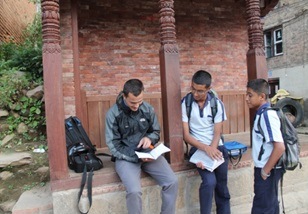Public open spaces with ponds, ancient temples and archeological sites, traditional settings for public rest places, the Patis (Falcha in local language) and fabulous designs – all are attractions of Kirtipur – a City of Glory. It is one of the historical and ancients places of Kathmandu. Open spaces are used for daily life activities, for cultural activities, rituals and recreation. In recent days, the attention to these spaces is decreasing, and the management is lacking.
Public open spaces with ponds, ancient temples and archeological sites, traditional settings for public rest places, the Patis (Falcha in local language) and fabulous designs – all are attractions of Kirtipur – a City of Glory. It is one of the historical and ancients places of Kathmandu. Open spaces are used for daily life activities, for cultural activities, rituals and recreation. In recent days, the attention to these spaces is decreasing, and the management is lacking. These spaces are encroached and several of the public water bodies are in poor conditions and left with drains and weeds while some have already lost their existence. Dey Pukhu, literally meaning ‘the state’s pond’, is situated at the heart of Kirtipur. The pond is surrounded by 4 attractive Falchas in its original setting. But in recent days these falchas have been encroached, and are replaced by private buildings. The land where once the public rest places were present – are now registered as private land. This is the hitting point where CIUD with UN-HABITAT’s support – initiated the people-centric approach to revitalize the town through mobilization of local communities and with restoration of its valuable ancient infrastructures which reflect the essence of the City of Glory. A series of community consultations, meetings with local prominent persons and coordination with local governmental authorities provided the base to initiate this pilot project. Mobilization of the youth, women and local leadership was a rudder which mechanized the wheel of the process. Formulation of Advisory Committee for local leadership is one of the examples of the process. As a pilot intervention – CIUD started the process for reconstruction of a Falcha at South-East corner of the premises around Dey Pukhu. This would require a legal process where the land owner (the land which was previously ‘public’ but now encroached) would agree to provide space for the reconstruction work. The project witnessed a start of coordination among local communities and local authority in the issues where the local team of youth led the process of negotiation between the land owners and the municipal corporation. The process eventually led into consensus for reconstruction of not only one Falcha but also all other three Falchas as well. Mr. Gyan Maharjan and Mr. Bharat Maharjan have agreed to provide permission for reconstruction of the Falcha located at the South-eastern corner of the premises around Dey Pukhu.
This is an example where the locals have shown initiation in revitalizing the situation from ‘lost situation’ to ‘reclaimed situation’. And by now the demonstrative reconstruction of the falcha has been completed. The local elderly people, women, youth and children – all are happy to see this change which was previously thought to be impossible.
But now – the chages are so remarkable. Locals have started using the public facility, and they find it very useful. Nikka Maharjan and Ramik Maharjan are the local students around the Dey Pukhu area. ‘We have to walk along the Dey Pukhu area to reach our school. Previously there used to be no place if anyone has to sit or rest around the area. The construction of Pati and chairs on the South West part of the pond has made us very easy to enjoy the view and rest during the free time. My grandfather also rests on the Falcha after his morning walk’ – mentions Nikka.

There are around 7-8 people regularly sitting in the falcha in the evening time, and this has given place for people to share things among friends and spend time in open. This is expected to promote the use of public places among the locals.
These are some of the many indicators of use of such public facilities by the people. With the initiation and facilitation by CIUD team, the local communities have stood stronger in need of managing the public open spaces and its key amenities so that the socialization process is restored, the local voice is heard in decision making and local have their collective efforts in sustainable management of public open spaces. The hopes are high and confidence higher among the locals for restoring dried-up ponds, reconstructing perished public rest places, reclaiming the encroached public spaces and being a part of the process – the change leading to revitalization.
